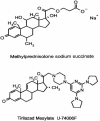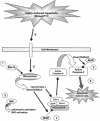Neuroprotection and acute spinal cord injury: a reappraisal
- PMID: 15717009
- PMCID: PMC534914
- DOI: 10.1602/neurorx.1.1.80
Neuroprotection and acute spinal cord injury: a reappraisal
Abstract
It has long been recognized that much of the post-traumatic degeneration of the spinal cord following injury is caused by a multi-factorial secondary injury process that occurs during the first minutes, hours, and days after spinal cord injury (SCI). A key biochemical event in that process is reactive oxygen-induced lipid peroxidation (LP). In 1990 the results of the Second National Acute Spinal Cord Injury Study (NASCIS II) were published, which showed that the administration of a high-dose regimen of the glucocorticoid steroid methylprednisolone (MP), which had been previously shown to inhibit post-traumatic LP in animal models of SCI, could improve neurological recovery in spinal-cord-injured humans. This resulted in the registration of high-dose MP for acute SCI in several countries, although not in the U.S. Nevertheless, this treatment quickly became the standard of care for acute SCI since the drug was already on the U.S. market for many other indications. Subsequently, it was demonstrated that the non-glucocorticoid 21-aminosteroid tirilazad could duplicate the antioxidant neuroprotective efficacy of MP in SCI models, and evidence of human efficacy was obtained in a third NASCIS trial (NASCIS III). In recent years, the use of high-dose MP in acute SCI has become controversial largely on the basis of the risk of serious adverse effects versus what is perceived to be on average a modest neurological benefit. The opiate receptor antagonist naloxone was also tested in NASCIS II based upon the demonstration of its beneficial effects in SCI models. Although it did not a significant overall effect, some evidence of efficacy was seen in incomplete (i.e., paretic) patients. The monosialoganglioside GM1 has also been examined in a recently completed clinical trial in which the patients first received high-dose MP treatment. However, GM1 failed to show any evidence of a significant enhancement in the extent of neurological recovery over the level afforded by MP therapy alone. The present paper reviews the past development of MP, naloxone, tirilazad, and GM1 for acute SCI, the ongoing MP-SCI controversy, identifies the regulatory complications involved in future SCI drug development, and suggests some promising neuroprotective approaches that could either replace or be used in combination with high-dose MP.
Figures




References
-
- Anderson DK, Hall ED. Pathophysiology of spinal cord trauma. Ann Emerg Med 22: 987–992, 1993. - PubMed
-
- Hall ED. Mechanisms of secondary CNS injury. In: Neurosurgery 96: manual of neurosurgery (Palmer JD, ed), pp 505–510. New York: Churchill-Livingstone, 1996.
-
- Hall ED, Braughler JM. Central nervous system trauma and stroke. II. Physiological and pharmacological evidence for involvement of oxygen radicals and lipid peroxidation. Free Radic Biol Med 6: 303–313, 1989. - PubMed
-
- Tator CH, Fehlings MG. Review of the secondary injury theory of acute spinal cord trauma with emphasis on vascular mechanisms. J Neurosurg 75: 15–26, 1991. - PubMed
-
- Faden AI. Therapeutic approaches to spinal cord injury. Adv Neurol 72: 377–386, 1997. - PubMed
Publication types
MeSH terms
Substances
LinkOut - more resources
Full Text Sources
Medical
Miscellaneous

